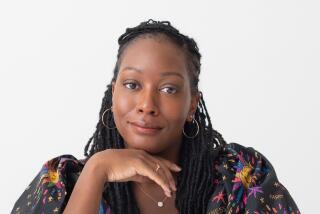Group Devotes Itself to Preserving Sanity, Friendship Among Parents
Chances are you won’t find this disease listed in any medical textbook. Nevertheless, there are plenty of people who believe it may be reaching epidemic proportions.
Early stages of the affliction, they say, are often marked by an increased sense of isolation and loneliness, followed by a dramatic decrease in vocabulary. Ordinarily intelligent, well-educated adults--usually women--find their everyday speech peppered with redundant usage of monosyllabic words, such as “Let’s go bye-bye in the car-car.” In acute cases, the person may have the uncontrollable urge in restaurants to walk over to a stranger’s plate and cut his or her meat into tiny pieces.
The disease, for many, is called parenthood. And for those who know the true meaning of the terrible twos, or a lack of reliable child care, the symptoms that stem from long-term isolation are very real and rarely something to laugh about.
For the last 15 years, a tightly knit organization has been reaching out to overwhelmed parents, offering them a comforting and often sanity-saving message: Parenthood is not fatal, and can even be fun.
Creative Parenthood, or “CP” as its members refer to it, is a nonprofit organization of more than 200 families throughout the Valley. Its primary function, said Vice President Karen Barkin, is to support one another in the formidable task of meeting the day-to-day demands of raising children, and at the same time to help members maintain a sense of personal identity.
Meeting the Demands
“One of the things we find as parents is that it’s very easy to lose a sense of who you are while you’re meeting everyone else’s demands,” Barkin said. “Sometimes it simply gets too much. What Creative Parenthood is all about is giving parents a support system, an opportunity to network with other families, and an outlet for themselves as well as their children.”
Although Creative Parenthood is a well-structured organization--staffed by a president, vice-president and two dozen positions on its board of directors--new members often stumble on it by chance. Trying to find Creative Parenthood in the phone book is a little like looking for Sesame Street on a road map. The group’s “main office” is simply at the home of whoever happens to be president at the time.
“Word of mouth often is the group’s best promotion,” Barkin said, “although we intermittently distribute brochures to YWCAs, hospital maternity wards and pediatrician offices throughout the Valley.” When its budget allows, she added, the group occasionally advertises in magazines published for new parents.
The all-volunteer organization has several different components. The play group committee schedules regular activities for up to seven children in the same age range, all living in the same area. Children meet about once a week in homes, and mothers get to take the afternoon off.
“The kids really get a chance to make friends with other children their own age,” said play group director Liz Hecht-Ward. “These are the kinds of lasting friendships where one kid invites the same friends to his birthday party for six years in a row.”
For mothers, the experience is often just as rewarding. “Believe me, when you have a first child and you know no one, or no one with babies, play groups can be very important to you,” said Diane Hilty, a mother of two, who also has organized Creative Parenthood’s weekly outings to the children’s summer concerts at the Hollywood Bowl. “It’s really a support system,” she said.
Parents learn to better deal with family problems during the organization’s “rap groups.” These consist of six to eight meetings a year on a variety of topics. Recent ones have included “Food, Family and the 5 O’Clock Hour,” where parents discussed the treacherous transition hour when the father or mother comes home from work at the exact time the children are apt to be hungry and tired; and “Choosing a Preschool,” where representatives from two nursery schools discussed their philosophies and encouraged parents to ask questions and share their experiences.
“Sometimes just being able to tell another parent who’s been through the wringer, ‘My child is biting me,’ and then to get some feedback about how to handle it is all you need,” said board member Vickie Addley, mother of a 3-year-old son.
But when members need advice from the experts they can attend lectures the group schedules six times a year with authorities on parenting from local colleges and universities. “We’ve had everything from parent-effectiveness training, potty training, discipline and child development phases, to earthquake preparedness, how to encourage your child to brush his teeth and how art can be used as therapy,” said Audrey Adams.
Topics that address early childhood development issues are repeated cyclically to meet the needs of new members with new babies, Adams said. Other subjects are suggested by members and frequently reflect current concerns of parents.
“Before all of the attention about child molestation, for example, we never would have scheduled a speaker meeting on that subject,” Adams said. “As it is, our next meeting will be on how parents can recognize the signs of molestation in young children, and how to deal with it if, God forbid, it should happen.”
Offshoots of Creative Parenthood are a baby-sitting co-op and a food co-op. The baby-sitting co-op has about 60 families as members, said co-op director Julie Patterson.
“Upon joining, each family is given a book with the names and addresses of other co-op members, along with a coupon book worth 20 hours of baby-sitting,” Patterson said. Members exchange a set number of coupons each hour, depending upon the number of children. Overnight sitting and pickups from school or the dentist also can be arranged, she said.
The co-op’s safety specifications, designed by Creative Parenthood’s board of directors, are stringent. “Before being allowed into the co-op, we send two people out to the home to check for certain things,” Patterson explained. “It’s not a white-glove test.” They make certain that all poisons are locked up, that pools are safely fenced off, that ammunition is locked away if there is a gun in the house, and check on other major safety considerations.
Besides knowing that their children are safe from pools and poisons, many members say they feel a greater sense of security leaving their children in the care of other adults.
“For one thing, other parents tend to have more planned activities, which is good for the kids,” Hilty said. “And then, as anyone who’s had a bad experience with a young sitter will tell you, you also don’t have to worry that something awful will happen to your child while the sitter is talking on the phone with her boyfriend. The level of responsibility is just a lot higher.” Annual membership in the co-op is $10.
Twelve years ago, in the same co-operative spirit, a food co-op was was begun by members of Creative Parenthood.
The food co-op buys produce in bulk and passes on the savings to members, according to director Phyllis Moss. After members fill out an order sheet and mail it in, two co-op members go downtown to the produce market at 2:30 a.m. and buy fruits and vegetables in large quantities, Moss said. “We get back about 5:30 a.m., at which time our packers begin putting the food into boxes. Members then can come pick up their food in the early afternoon.”
Besides substantial financial savings, one of the greatest benefits is the higher quality and freshness of the produce, Moss said. Anyone is welcome in the co-op, and need not be a member of Creative Parenthood to join. (Moss can be reached weekdays from 9 a.m. to 5 p.m. at 764-2997.)
Most mothers in Creative Parenthood do not work outside the home, said membership director Donna Ryan, but the organization offers support to those who do.
Evie Quinn, a full-time special education teacher and mother of two, discovered Creative Parenthood through a brochure in her pediatrician’s office when her youngest child was 2 months old.
“I had desperately been looking for an organization or outlet where there were other parents,” said Quinn, rap session director. “My husband is a native Californian and had a tremendous amount of friends he’d had for 15 or 20 years, most of whom either had older or no children. I’m a native New Yorker, and really didn’t know anyone here. So, during those first years,” she said, “I was pretty much alone.”
After returning to work for several years and having “little or no resources as far as child care was concerned,” Quinn had another child. It was then that she discovered Creative Parenthood.
‘Chance to Network’
“The chance to network with other families, get out of the house regularly--and not just go to work--as well as the support offered by involvement in the babysitting co-op, has really changed my life,” Quinn said. “The only thing I regret is not having found out about this four years ago.”
In many respects, the organization’s activities and philosophies reflect a changing trend in society’s approach to child rearing, said Tom Kennon, a childhood development expert and Ph.D candidate at UCLA who is working on a book about what he calls “artistic parenting.”
“In the 1700s, society’s approach to child rearing was primarily one of methodology,” Kennon said. “Parents raised their children according to how they were raised. In the 1800s, the approach became more based upon logic, that if you did a certain thing, there would follow a desired result.”
That logical approach, Kennon said, extended into the 1900s, but gradually began moving into the realm of “the three I’s”--instinct, intuition and imagination. With the publication of Dr. Benjamin Spock’s book, “Baby and Child Care,” parents for the first time were encouraged to rely more heavily on their instincts and imagination than on pure logic, he said.
“What these parents are rediscovering are those creative, imaginative things that aren’t necessarily classroom-types of systematic or scientific learning,” Kennon said. “It’s learning, but it’s learning in a very relaxed way. We need structured learning, but we also need to have the leisurely side of it--the side that helps us get in touch with our kids.”
For parents of young children who feel they may be just a little too much in touch with their kids, Creative Parenthood presents an opportunity to meet other parents who have had their similar feelings--and survived to tell about them.
“If you look at parenting as a job, you’re bound to get burned out,” said member Vickie Addley. “There’s always more to be done, and whatever you do is never enough. But, if you can look at it as a chance for both you and your child to grow and experience things together, you find there’s really a lot of joy in it.”
Those interested in Creative Parenthood should call membership director Donna Ryan between 9 a.m. and 5 p.m. weekdays at 909-7735.


